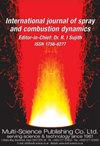湍流均匀燃料-空气混合物中燃料Lewis数对最小点火能量及其跃迁的影响
IF 2.1
4区 工程技术
Q3 ENGINEERING, MECHANICAL
International Journal of Spray and Combustion Dynamics
Pub Date : 2023-07-19
DOI:10.1177/17568277231187494
引用次数: 0
摘要
使用三维直接数值模拟,分析了燃料路易斯数对确保成功热失控的最小点火能量(MIE)要求以及均匀燃料-空气混合物在衰减湍流下的自持火焰传播的影响。已发现,无论大湍流强度的结果如何,确保自持火焰传播的最小能量需求都大于仅确保热失控的最小能量要求,并且无论燃料路易斯数如何,最小点火能量都随着均方根湍流速度的增加而增加。已经发现MIE值随着湍流强度的增加而急剧增加,超过此处考虑的所有燃料Lewis数的临界值。归一化MIE(通过其层流值归一化的MIE)随着湍流强度的增加而超过临界点的变化遵循幂律,并且幂律指数随着燃料Lewis数的增加而增加。这种行为已经通过比例分析进行了解释。通过对与MIE相对应的能量输入使用统计上相似的湍流场的不同实现,已经证明了与强制点火相关的随机性,并且在大多数情况下都获得了成功的结果,证明了本分析中MIE值的评估是合理的。本文章由计算机程序翻译,如有差异,请以英文原文为准。
Effects of fuel Lewis number on the minimum ignition energy and its transition for turbulent homogeneous fuel–air mixtures
The effects of fuel Lewis number on the minimum ignition energy (MIE) requirements for ensuring successful thermal runaway, and self-sustained flame propagation have been analysed for forced ignition of homogeneous fuel–air mixtures under decaying turbulence for a wide range of initial turbulence intensities using three-dimensional direct numerical simulations. The minimum energy demand for ensuring self-sustained flame propagation has been found to be greater than that for ensuring only thermal runaway irrespective of its outcome for large turbulence intensities, and the minimum ignition energy increases with increasing rms turbulent velocity irrespective of the fuel Lewis number. The MIE values have been found to increase more sharply with increasing turbulence intensity beyond a critical value for all fuel Lewis numbers considered here. The variations of the normalised MIE (MIE normalised by its laminar value) with increasing turbulence intensity beyond the critical point follow a power-law and the power-law exponent has been found to increase with an increase in fuel Lewis number. This behaviour has been explained using a scaling analysis. The stochasticity associated with forced ignition has been demonstrated by using different realisations of statistically similar turbulent flow fields for the energy inputs corresponding to the MIE and successful outcomes are obtained in most instances, justifying the evaluation of the MIE values in this analysis.
求助全文
通过发布文献求助,成功后即可免费获取论文全文。
去求助
来源期刊

International Journal of Spray and Combustion Dynamics
THERMODYNAMICS-ENGINEERING, MECHANICAL
CiteScore
2.20
自引率
12.50%
发文量
21
审稿时长
>12 weeks
期刊介绍:
International Journal of Spray and Combustion Dynamics is a peer-reviewed open access journal on fundamental and applied research in combustion and spray dynamics. Fundamental topics include advances in understanding unsteady combustion, combustion instability and noise, flame-acoustic interaction and its active and passive control, duct acoustics...
 求助内容:
求助内容: 应助结果提醒方式:
应助结果提醒方式:


